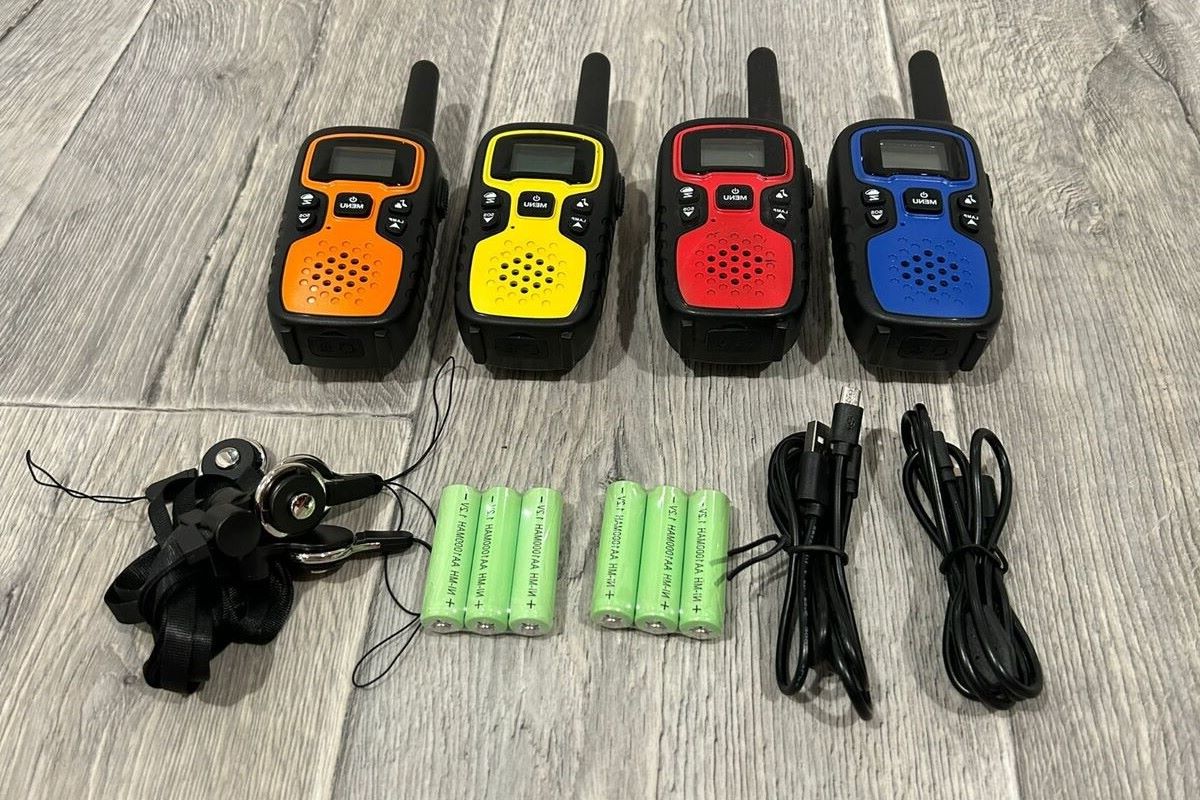
Ever wondered how walkie talkies revolutionized communication? These handy devices, also known as handheld transceivers, have a rich history dating back to the 1930s. Invented by Canadian engineer Donald Hings, walkie talkies were initially designed for pilots. Their significance skyrocketed during World War II when the US military adopted them for crucial operations. Today, they are indispensable in various fields, from military and business to recreational activities. With features like noise cancellation, weather alerts, and SOS signals, modern walkie talkies are more advanced than ever. Dive into these 45 fascinating facts to learn how walkie talkies have evolved and why they remain essential tools in our tech-savvy world.
Key Takeaways:
- Walkie talkies were invented in 1937 and played a crucial role in World War II, saving thousands of lives. They continue to be essential in various industries and are even used for recreational purposes like hunting and fishing.
- The walkie talkie market is booming, with the global market valued at $14.7 billion and expected to grow to $32 billion by 2033. Modern walkie talkies come with advanced features like SOS signals, weather alerts, and digital squelch, making them versatile communication devices.
The Birth of Walkie Talkies
Walkie talkies have been around for decades, evolving from bulky military devices to sleek, modern gadgets. Let's dive into their fascinating history and development.
- The first walkie talkie was invented in 1937 by Canadian engineer Donald Hings. Initially designed to help pilots communicate, it became known as the "packset" due to its portability.
- During World War II, the term "walkie talkie" gained popularity. The US military developed the first handheld walkie talkie, the AM SCR-356 transceiver, produced by Motorola. This device played a crucial role in military operations, saving thousands of lives.
- Walkie talkies work by converting words into radio waves using a push-to-talk button to switch between talking and listening modes. They use a single radio channel but can allow multiple users to listen in on the conversation.
Types and Uses of Walkie Talkies
Walkie talkies come in various forms and serve different purposes, from professional use to recreational activities.
- There are two main types of walkie talkies: portable and stationary. Portable walkie talkies have built-in batteries and are compact, making them easy to carry. Stationary radios, on the other hand, require a separate power source and are often mounted indoors or on vehicles.
- Professional walkie talkies are designed for heavy use and come with advanced features like noise cancellation technology and alarm integration. Amateur radios, used for recreational purposes, are less feature-rich but more affordable and easy to use.
- The communication range of a walkie talkie is affected by several factors including transmitter power, antenna height, and environmental conditions. Typically, a walkie talkie can cover a distance of 5-6 kilometers (3-4 miles) under ideal conditions.
- The optimal power for a walkie talkie is generally considered to be 3-5 watts. This range provides a balance between coverage and battery life.
- Walkie talkies operate on various frequencies including UHF (Ultra High Frequency), VHF (Very High Frequency), and LPD (Low Power Digital). The choice of frequency depends on the intended use and local regulations.
Historical Significance and Modern Features
Walkie talkies have played a significant role in history and continue to be essential in various industries today.
- Walkie talkies have played a significant role in historical events. During World War II, they were instrumental in military operations. In the 1960s, they were used by astronauts during space missions. Today, they continue to be essential in various industries.
- Modern walkie talkies come equipped with advanced features such as flashlights, SOS signals, weather alerts, and digital and analog squelch. These features enhance the device's functionality and reliability.
- Walkie talkies are still widely used by the military for secure communication. They are designed to be rugged and reliable, withstanding harsh environments and extreme temperatures.
- Businesses also rely heavily on walkie talkies for communication in areas without mobile service. They are used in industries such as construction, logistics, and healthcare.
- Walkie talkies are not just limited to professional use; they are also popular among recreational users. They are used by hunters, fishermen, and tourists for communication in remote areas.
- For children, toy walkie talkies are a fun way to learn about communication technology. These devices are affordable and available for under $50, making them accessible to many families.
Market Value and Growth
The walkie talkie market is booming, with significant growth expected in the coming years.
- The global walkie talkie market is valued at $14.7 billion and is expected to grow to $32 billion by 2033, with an annual growth rate (CAGR) of 8.1%.
- The Asia Pacific region is projected to drive 49% of the market's growth by 2027, making it a key area for expansion. North America currently leads as the biggest market due to increased government spending on security equipment.
- Despite North America's strong position, the Asia Pacific is emerging as the fastest-growing market from 2023 to 2027. This shift highlights the increasing demand for walkie talkies in various regions.
- The Rocky Talkie model stands out as the best walkie talkie based on tests and reviews. The top model of a walkie talkie averages around $110, while basic models offering 1 to 2 kilometers (approximately 1 to 1.5 miles) of coverage are more affordable and widely used.
Key Figures and Innovations
Several key figures and innovations have shaped the development of walkie talkies.
- Walkie talkies are also known as handheld transceivers (HTs). They operate on a single radio channel but can allow multiple users to listen in on the conversation.
- The technology behind walkie talkies was developed by key figures including Alfred J. Gross, Henryk Magnuski, and Donald Hings. These inventors, along with engineering teams from Motorola, played a crucial role in its creation and evolution.
- Donald Hings was recognized by the Telecommunications Hall of Fame in 2006 for his contributions to telecommunications technology. His modifications of the two-way radio, which he evolved into the world's first functional and operational walkie talkie, saved thousands of lives during World War II.
- Hings was later named a Member of the Order of the British Empire and of the Order of Canada for his outstanding contributions to engineering and telecommunications.
Design and Performance
Walkie talkies are designed to be portable, durable, and reliable, making them suitable for various applications.
- Walkie talkies are designed to be portable and compact. They typically weigh between 100-200 grams and have dimensions that allow them to be easily carried in a pocket or attached to a belt.
- The average strength of a walkie talkie signal is 0.25 watts and can transmit about 500 to 1,000 feet. This range can vary depending on the environment and the height of the antenna.
- The communication range of a walkie talkie is affected by environmental factors such as topography, altitude, air humidity, and weather. These factors can significantly impact the device's performance.
- The topography of the area can affect the communication range. For example, in deciduous and coniferous forests, the range may be different due to the density of trees and other obstacles.
- Altitude above sea level can also impact the communication range. Higher altitudes may reduce the range due to atmospheric conditions.
- Air humidity can affect the signal strength and range. High humidity can reduce the signal strength, while low humidity can improve it.
- Weather conditions such as rain, snow, and fog can significantly impact the communication range. Inclement weather can reduce the signal strength and range.
- Frequency interference from other devices can also affect the communication range. This interference can be minimized by using devices with advanced filtering systems.
Advanced Features and Capabilities
Modern walkie talkies come with a range of advanced features that enhance their functionality and reliability.
- Modern walkie talkies come with digital and analog squelch features. These features help to reduce noise and improve signal quality, enhancing overall communication.
- Some walkie talkies offer remote operation capabilities, allowing users to control the device from a distance. This feature is particularly useful in industrial settings where multiple devices need to be managed.
- Many walkie talkies come equipped with SOS signals that can be activated in emergency situations. These signals help to quickly alert others in case of an emergency.
- Some walkie talkies include weather alert features that provide real-time weather updates. This feature is useful for outdoor activities and emergency preparedness.
- Many modern walkie talkies include built-in flashlights that provide light in low-light conditions. This feature is particularly useful for outdoor activities and emergency situations.
- Professional walkie talkies often come with noise cancellation technology that helps to reduce background noise and improve signal quality. This feature is essential in noisy environments such as construction sites or industrial facilities.
- Some walkie talkies include alarm integration capabilities that allow users to set alarms and receive notifications. This feature is useful in industrial settings where timely alerts are crucial.
- Walkie talkies can operate on multiple channels, allowing multiple users to communicate simultaneously. This feature is essential in group communications where multiple users need to be connected.
- Some walkie talkies come with channel scanning features that allow users to scan through different channels to find the best signal. This feature is useful in areas with high frequency interference.
- Some advanced walkie talkies include encryption features that provide secure communication. This feature is essential in military and government communications where security is paramount.
Battery Life and Durability
Walkie talkies are designed to be durable and have long battery life, making them suitable for various applications.
- The battery life of a walkie talkie depends on the device's power consumption and usage patterns. Typically, a walkie talkie can last several hours on a single charge, depending on the device's specifications.
- Walkie talkies often come with various charging options such as USB charging, battery replacement, and solar charging. These options ensure that the device remains operational even in remote areas with limited power sources.
- Walkie talkies are designed to be durable and rugged. They are built to withstand harsh environments and extreme temperatures, making them suitable for various applications.
- Walkie talkies are cost-effective communication devices. They do not require cell towers or subscription fees, making them an affordable option for businesses and individuals alike.
- Walkie talkies are versatile communication devices that can be used in various settings including military operations, business communications, recreational activities, and emergency situations. Their adaptability and reliability make them an essential tool in modern communication technology.
Walkie Talkies: A Timeless Communication Tool
Walkie talkies have come a long way since their invention in the 1930s. From military operations during World War II to modern-day business and recreational use, these devices have proven their worth time and again. They offer reliable communication in areas where mobile service is unavailable, making them indispensable in various industries. With features like noise cancellation, weather alerts, and SOS signals, modern walkie talkies are more advanced and versatile than ever. Their durability and cost-effectiveness make them a practical choice for both professional and personal use. As technology continues to evolve, walkie talkies remain a crucial tool in our communication arsenal. Whether you're a hiker, a construction worker, or just someone who loves gadgets, walkie talkies offer a reliable and straightforward way to stay connected.
Frequently Asked Questions
Was this page helpful?
Our commitment to delivering trustworthy and engaging content is at the heart of what we do. Each fact on our site is contributed by real users like you, bringing a wealth of diverse insights and information. To ensure the highest standards of accuracy and reliability, our dedicated editors meticulously review each submission. This process guarantees that the facts we share are not only fascinating but also credible. Trust in our commitment to quality and authenticity as you explore and learn with us.


